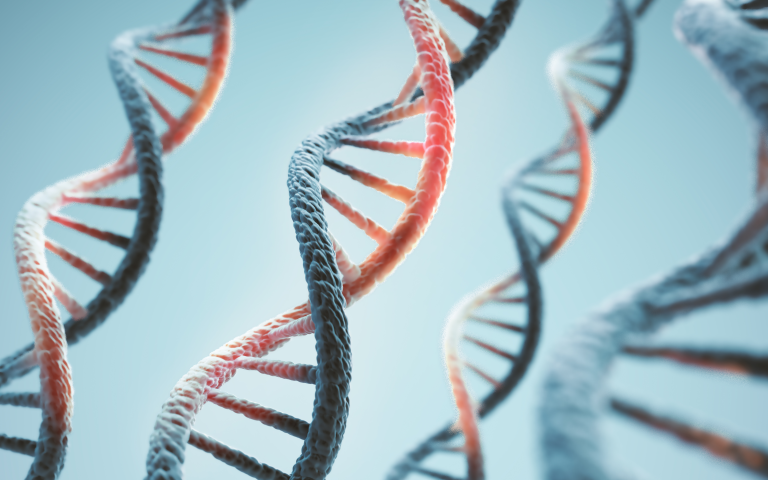Written by Dr. By Marija Cvetanovic Edited by Dr. Larissa Nitschke
Suart et al. show that Ataxin-1 interacts with an important DNA repair protein Ataxia telangiectasia mutated (ATM), and that reduction of ATM improves motor phenotype in the fruit fly model of SCA1, indicating DNA repair as an important modifier of SCA1 disease progression.
Each day, due to a combination of wear and tear from the normal processes in the cells, and environmental factors, such as irradiation, DNA in each of our cells can accumulate from 10,000 to 1,000,000 damages. If damaged DNA is left unrepaired, this can lead to loss of cell function, cell death, or a mutation that may facilitate the formation of tumors. To avoid these negative outcomes, cells take care of damaged DNA employing DNA damage response/repair proteins. Ataxia-telangiectasia mutated (ATM) protein is a critical part of DNA repair as it can recognize sites of DNA damage. It also helps recruit other proteins that repair DNA damage.
Mutations in the ATM gene cause autosomal recessive ataxia called Ataxia telangiectasia (AT). AT is characterized by the onset of ataxia in early childhood, prominent blood vessels (telangiectasia), immune deficiency, an increased rate of cancer, and features of early ageing.

Expansion of CAG repeats in the Ataxin-1 gene causes dominantly inherited Spinocerebellar Ataxia Type 1 (SCA1). A feature of SCA1 is that a greater number of repeats correlates to an earlier age of onset of symptoms and worse disease progression. The connection of DNA repair pathways and SCA1 was brought into focus in 2016 by a study by Bettencourt and colleagues. As longer CAG repeat tracts association with earlier ages at onset do not account for all of the difference in the age of onset authors searched for additional genetic modifying factors in a cohort of approximately 1000 patients with SCAs. They showed that DNA repair pathways significantly associate with the age at onset in SCAs, suggesting that genes with roles in the DNA damage response could provide new therapeutic targets (and hence therapeutics) in SCAs.
In this study, Suart et al. identify ATM as one such gene. Using irradiation and oxidizing agent to damage DNA and using imaging to follow ataxin-1 movement, authors first show that ataxin-1 is recruited to the site of DNA damage in cultured cells. They also demonstrate that SCA1 mutation slows down but does not prevent ataxin-1 recruitment to the sites of DNA damage.
Next, the authors used drugs to reduce ATM activity or RNA interference to reduce ATM protein levels. Without active ATM, ataxin-1 was not able to localize to the sites of DNA damage.
Using skin cells from patients with SCA1, the authors found that the SCA1 mutation in ataxin-1 in turn also reduces ATM activity. This indicates an interesting reciprocal relationship between ATM and ataxin-1 in which ATM recruits ataxin-1 to the sites of DNA damage, and ataxin-1 in turn also regulates ATM activity.
Finally, to examine what, if any, effect does the interaction of ATM and ataxin-1 has on SCA1 symptoms, the authors used a fruit fly model of SCA1. When flies express mutant ataxin-1 (SCA1 flies), they show motor deficits meaning they climb slower when tapped to the bottom of a jar. On the other hand, SCA1 flies with only half of ATM present climbed much faster. In fact, they were as good climbers as healthy flies. This result indicates that partial reduction of ATM activity protects from ataxia in a fly model of SCA1.
Overall, these results connect findings from the genetic studies aiming to identify genes that modulate age of onset in SCA1 with the role of particular DNA repair gene ATM in the SCA1 pathogenesis. These results support pursuing inhibition of ATM as a potential therapeutic target for SCA1.
Key Terms
RNA Interference: a mechanisms to reduce levels of specific RNA in cells. You can learn more about it in this Snapshot.
Conflict of Interest Statement
The author and editor declare no conflict of interest. CE Suart, T Maiuri, and R Truant, who are authors of this research study, are contributors to SCAsource. They did not participate in the writing or editing of this article.
Citation of Article Reviewed
Suart CE, Perez AM, Al-Ramahi I, Maiuri T, Botas J, Truant R. Spinocerebellar Ataxia Type 1 protein Ataxin-1 is signaled to DNA damage by ataxia-telangiectasia mutated kinase. Human Molecular Genetics. 2021 Apr 15;30(8):706-15. https://pubmed.ncbi.nlm.nih.gov/33772540/










